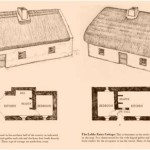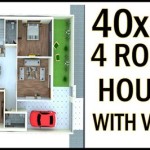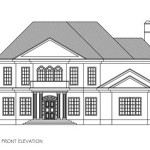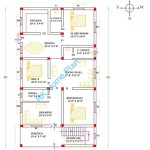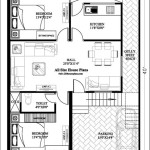Basic Floor Plans Home Design
A well-designed floor plan is the foundation of any successful home. It dictates the flow of space, the functionality of rooms, and the overall livability of the dwelling. Understanding the basics of floor plan design is crucial for anyone embarking on a home building or renovation project. This article explores the fundamental principles of creating effective and efficient floor plans for various home types and sizes.
Key Considerations for Basic Floor Plans
Several factors influence the design of a basic floor plan. These considerations should be addressed early in the planning process to ensure a functional and comfortable living space.
- Lifestyle Needs: Consider the occupants' daily routines, hobbies, and future needs.
- Lot Size and Orientation: The size and orientation of the building lot will impact the layout and placement of the home.
- Budget: Establish a realistic budget that encompasses all aspects of the project, from design fees to construction costs.
- Local Building Codes: Adhere to local building codes and regulations regarding setbacks, height restrictions, and other requirements.
- Accessibility: Incorporate accessibility features for individuals with mobility challenges.
Basic Floor Plan Types
Several basic floor plan types serve as starting points for home design. These templates can be adapted and modified to suit individual needs and preferences.
- Open Floor Plan: This popular design features combined living, dining, and kitchen areas, creating a spacious and social environment.
- Closed Floor Plan: This traditional layout separates rooms with walls, offering greater privacy and noise reduction.
- Single-Story Floor Plan: Ideal for aging in place or families with young children, these plans eliminate the need for stairs.
- Two-Story Floor Plan: These plans maximize square footage on smaller lots and often separate living spaces from sleeping areas.
- Split-Level Floor Plan: This design typically features three or four staggered levels, creating distinct zones within the home.
Essential Elements of a Floor Plan
Regardless of the chosen floor plan type, certain elements are essential for creating a functional and comfortable living space.
- Living Spaces: Designate adequate space for living areas, including living rooms, family rooms, and entertainment areas.
- Kitchen: The kitchen is the heart of the home. Consider its layout, functionality, and connection to other spaces.
- Dining Area: Provide a designated space for dining, whether it's a formal dining room or a casual eating area.
- Bedrooms: Ensure bedrooms are appropriately sized and located for privacy and comfort.
- Bathrooms: Plan for sufficient bathrooms based on the number of occupants and their needs.
- Storage: Incorporate ample storage space throughout the home, including closets, pantries, and garage storage.
- Circulation: Plan for efficient and logical traffic flow within the home, minimizing wasted space and maximizing functionality.
Optimizing Space and Functionality
Maximizing space and functionality is crucial, particularly in smaller homes. Careful planning can create a comfortable and efficient living environment.
- Multi-functional Spaces: Designate areas that can serve multiple purposes, such as a guest room that doubles as a home office.
- Built-in Storage: Maximize vertical space with built-in shelves, cabinets, and drawers.
- Natural Light: Utilize natural light to brighten spaces and create a sense of openness.
- Traffic Flow: Plan walkways and hallways to minimize congestion and ensure smooth traffic flow.
Drawing and Interpreting Floor Plans
Floor plans are typically drawn to scale, providing a visual representation of the home's layout. Understanding how to interpret these drawings is essential for effective communication during the design and construction process.
- Scale and Dimensions: Floor plans are drawn to a specific scale, allowing for accurate measurement of rooms and spaces.
- Symbols and Notation: Standard symbols and notations represent doors, windows, fixtures, and other architectural elements.
- Room Labels: Clearly label each room to avoid confusion and ensure accurate interpretation.
- Wall Thickness: Indicate wall thickness to accurately represent the overall dimensions of the home.
Software and Tools for Floor Plan Design
Various software programs and online tools can assist with creating and modifying floor plans. These resources range from simple drawing tools to sophisticated 3D modeling software.
- CAD Software: Computer-aided design (CAD) software provides advanced tools for creating detailed and accurate floor plans.
- Online Floor Plan Tools: Numerous online platforms offer user-friendly interfaces for creating and visualizing floor plans.
- Graph Paper and Templates: For basic floor plan sketching, graph paper and templates can be helpful tools.
Working with Professionals
While DIY floor plan design is possible, consulting with qualified professionals can ensure a well-designed and functional home. Architects and designers bring expertise in space planning, building codes, and construction practices.
- Architects: Architects can provide comprehensive design services, from initial concept development to construction drawings.
- Interior Designers: Interior designers can assist with space planning, furniture layout, and material selection.
- Contractors: Contractors can offer valuable insights into construction feasibility and cost estimations.
Adapting Basic Floor Plans
Basic floor plans serve as starting points and can be adapted to meet specific needs and preferences. Modifications can enhance functionality and personalize the living space.
- Expanding Rooms: Consider expanding key living areas, such as the kitchen or living room, to create more spacious environments.
- Adding Rooms: Adding bedrooms, bathrooms, or other functional spaces can accommodate changing lifestyle needs.
- Reconfiguring Spaces: Reimagine the layout of existing rooms to improve functionality and traffic flow.
- Outdoor Living Spaces: Integrate outdoor living spaces, such as patios, decks, and porches, to extend the living area.

Floor Plans Types Symbols Examples

Small House Design 2024001 Pinoy Eplans Floor Plans

House Plans How To Design Your Home Plan

2d Floor Plans Simple Small Kitchen Design Home

Floor Plans Learn How To Design And Plan

Affordable Home Design Efficient Floor Plans

12 Examples Of Floor Plans With Dimensions

Floor Plans Learn How To Design And Plan

18 Small House Designs With Floor Plans And Decors Modern Pictures

Stylish And Simple Inexpensive House Plans To Build Houseplans Blog Com

